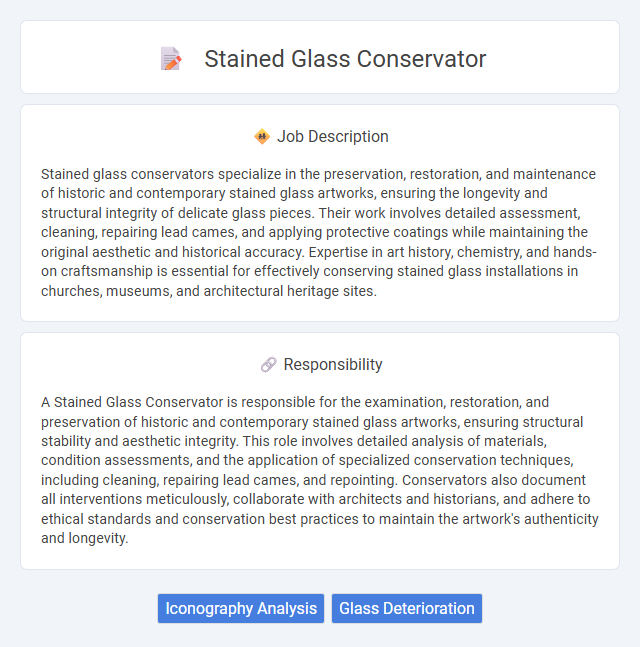
Stained glass conservators specialize in the preservation, restoration, and maintenance of historic and contemporary stained glass artworks, ensuring the longevity and structural integrity of delicate glass pieces. Their work involves detailed assessment, cleaning, repairing lead cames, and applying protective coatings while maintaining the original aesthetic and historical accuracy. Expertise in art history, chemistry, and hands-on craftsmanship is essential for effectively conserving stained glass installations in churches, museums, and architectural heritage sites.
Individuals with strong attention to detail and patience are likely suited for a career as a stained glass conservator, as the role requires meticulous repair and preservation of fragile artwork. Those with good hand-eye coordination and an interest in art history may have a higher probability of success in this job. People prone to frustration or lacking fine motor skills might find the precise and delicate nature of this work challenging.
Qualification
A stained glass conservator must possess specialized training in art restoration, with a strong foundation in chemistry and materials science to understand glass composition and deterioration processes. Proficiency in historical research and documentation ensures accurate preservation aligned with the artwork's original integrity. Certification from recognized conservation institutes and experience with both traditional and modern conservation techniques are essential qualifications for this role.
Responsibility
A Stained Glass Conservator is responsible for the examination, restoration, and preservation of historic and contemporary stained glass artworks, ensuring structural stability and aesthetic integrity. This role involves detailed analysis of materials, condition assessments, and the application of specialized conservation techniques, including cleaning, repairing lead cames, and repointing. Conservators also document all interventions meticulously, collaborate with architects and historians, and adhere to ethical standards and conservation best practices to maintain the artwork's authenticity and longevity.
Benefit
Stained glass conservators likely enjoy the benefit of preserving historic and artistic heritage, which can offer a strong sense of fulfillment and purpose in their work. They probably have opportunities to develop specialized skills in art restoration and conservation techniques that are rare and in demand. The role may also provide a unique blend of creativity and technical expertise, potentially leading to a stable career with niche professional recognition.
Challenge
Working as a stained glass conservator likely involves the challenge of carefully preserving fragile and often centuries-old materials without compromising their historical integrity. The necessity to balance traditional craftsmanship with modern restoration techniques probably demands high precision and expertise. There may also be complexities related to matching original colors and textures while preventing further deterioration.
Career Advancement
Stained glass conservators enhance their expertise by mastering material science, art history, and restoration techniques, which positions them for advanced roles in museums, historical societies, and conservation firms. Gaining certifications such as the American Institute for Conservation (AIC) credentials increases professional credibility and access to high-profile projects. Leadership opportunities arise by overseeing preservation teams or managing large-scale restoration initiatives on heritage buildings and cathedrals.
Key Terms
Iconography Analysis
Stained glass conservators specialize in the preservation and restoration of historic windows by meticulously analyzing iconography to understand artistic themes and cultural significance. Iconography analysis involves identifying symbolic motifs, color schemes, and stylistic elements to ensure accurate conservation that respects the original narrative and craftsmanship. This process aids in making informed decisions about cleaning, repair, and replication techniques, preserving the artwork's integrity and historical context.
Glass Deterioration
Stained glass conservators specialize in diagnosing and treating glass deterioration caused by environmental factors such as moisture, pollution, and UV radiation. They employ advanced restoration techniques to stabilize and repair cracks, corrosion, and paint loss while preserving the original materials and historical integrity. Regular condition assessments and preventive conservation strategies are essential to prolong the lifespan of stained glass artworks.
 kuljobs.com
kuljobs.com